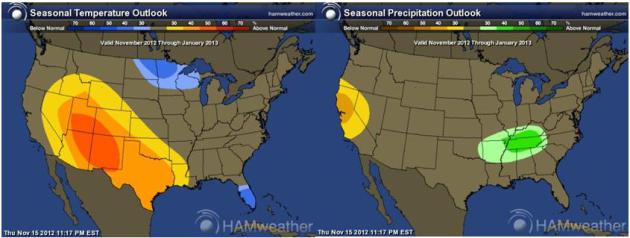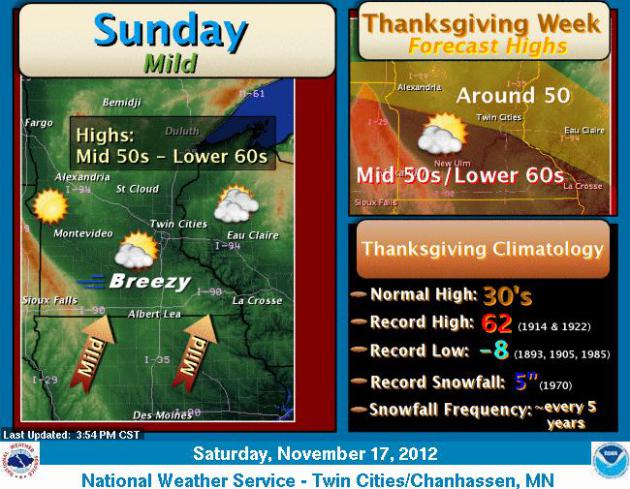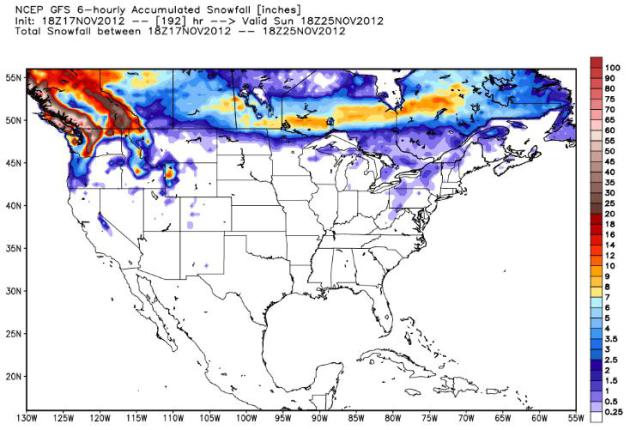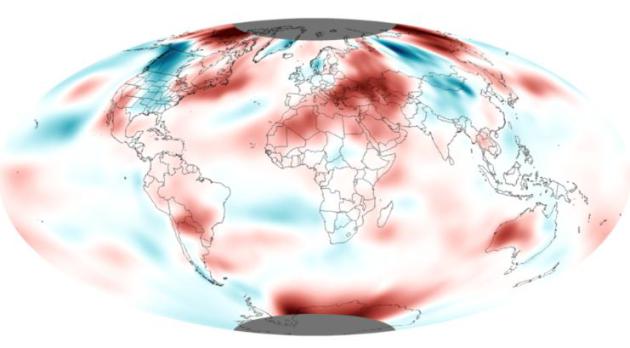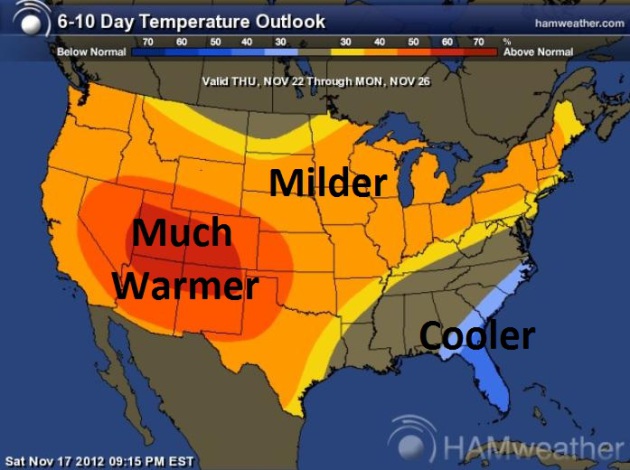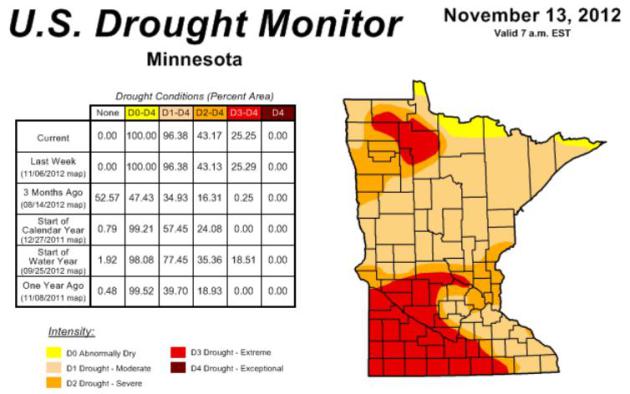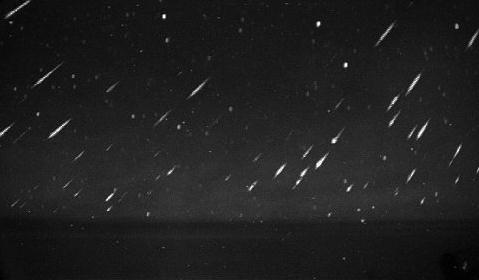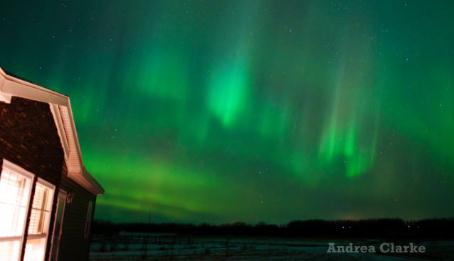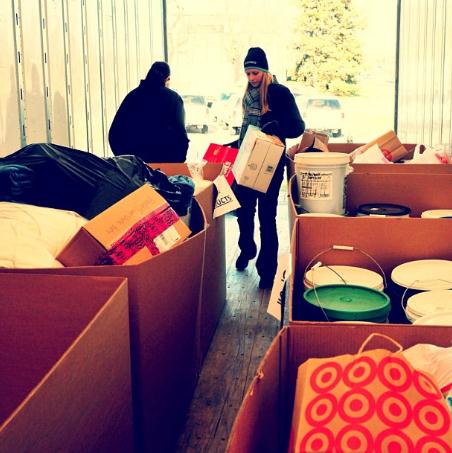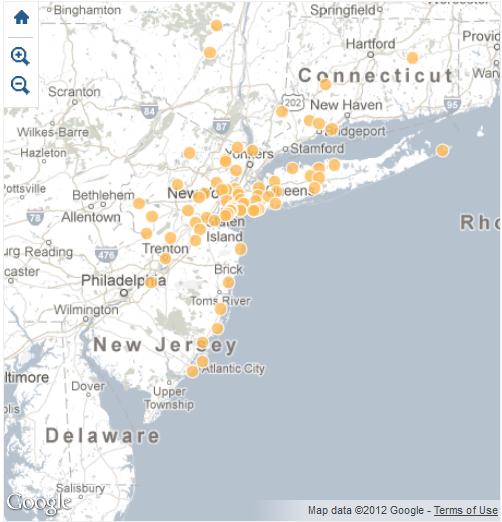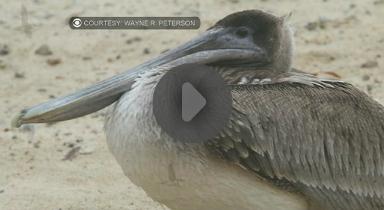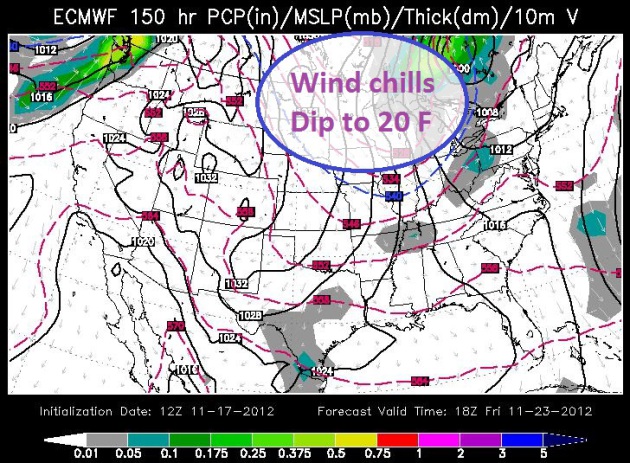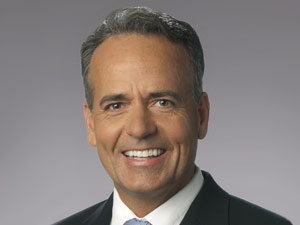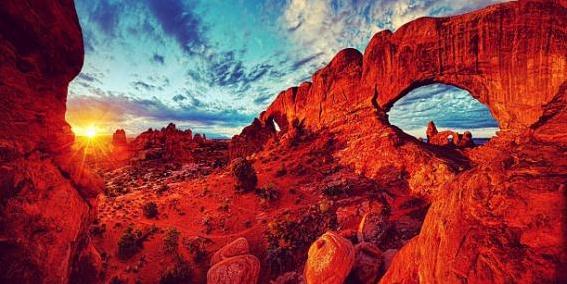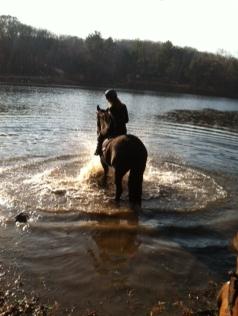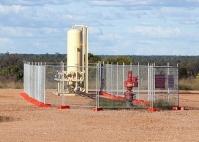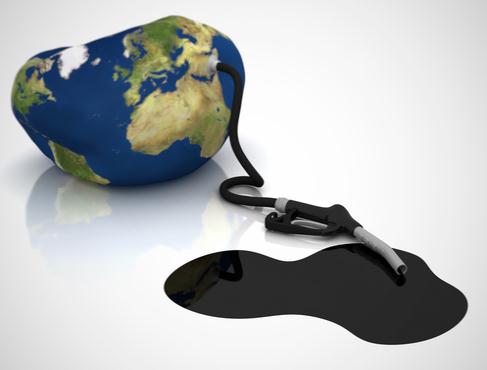Confidence Factor
Just what you need - one more number to
remember. By the end of some weather reports I can't even remember my
name, much less what the high will be a week from Tuesday. But in the
spirit of honesty, transparency & setting expectations
meteorologists should consider leveling with the public.
We consult with Fortune 100 companies in New
York City. 8 days before Sandy hit I gave a Confidence Factor of 35
percent that Sandy would hook inland and hit the USA. 4 days later that
number rose to 70 percent. It's not the value but the trend, and we
should be honest with viewers & readers on the days when uncertainty
is extra-high.
My Confidence Factor is 80 percent Thanksgiving
Day will be cloudy but mild; highs near 50 with a sprinkle or two. A
colder front sails into town "Black Friday", with highs stuck in the 30s
and a numbing breeze. We thaw out next weekend, but a surge of cold air
pushing into the west coast may twist upper air jet stream winds to the
southwest by late November, which may finally pump enough moisture
north for some significant rain or snow.
Below is a revised winter outlook from NOAA. They admit their Confidence Factor is low.
It's still anyone's guess.
Revised Winter Outlook (Don't Hold Your Breath).
NOAA's Climate Prediction Center has tweaked the November thru January
forecast for the USA, calling for milder than average over the Southwest
and Southern Plains with a 30-40% risk of colder than normal
conditions across the eastern Dakotas, Minnesota and northern
Wisconsin. This is based on a fading El Nino signal in the Pacific, and
a negative phase of the NAO, the North Atlantic Oscillation, which may
keep prevailing jet stream winds howling from the northwest much of
the winter. But CPC admits that this is a very difficult forecast, I
get the sense that confidence levels are low. I'm not convinced we're
going to wind up with a colder than normal winter, at least not yet.
Maps above: CPC and
Ham Weather.
Weather Story. If the sun stays out much of today
(quite possible) we stand a good chance of seeing 60 F. in the Twin
Cities, about 20 degrees warmer than average. Boating and golfing on the
18th day of November? Why not? We cool off a bit by Tuesday, but
temperatures rebound midweek - Thanksgiving Day highs near 50 before
colder air arrives in time for Friday power-shopping. Graphic above
courtesy of the
Twin Cities NWS.
Total Snowfall By Midday Sunday. Snowmobiles and
cross country skis will collect dust for at least another week, probably
longer, I fear. The GFS model keeps the most significant snow just
north of the U.S. Canadian border thru next weekend; some 12-24" amounts
for the Cascade Range of the Pacific Northwest - a litlte lake effect
snow kicking in near Cleveland and Buffalo behind Friday's cold shot.
But for the most part: winter takes the week off, nationwide.
October: 5th Warmest On Record. Details from
NOAA's Environmental Visualization Laboratory: "
Recently
released analysis by NOAA scientists at the National Climatic Data
Center reveals that October 2012 was the 5th warmest on record, dating
back to 1880. This image, using data from NCDC’s Global Historical
Climatology Network shows areas of warmer (red) and cooler (blue) than
normal temperatures. While extreme warmth dominated the high latitudes,
higher-than-average monthly temperatures were observed across much of
Europe, western and far eastern Asia, northeastern and southwestern
North America, central South America, northern Africa, and most of
Australia. Meanwhile, much of northwestern and central North America,
central Asia, parts of western and northern Europe, and southern Africa
were notably below average...."
Time Warp. NOAA CPC's 6-10 day temperature outlook
keeps most of America warmer than average thru the end of next week,
much warmer for the Southwest, but cooler than average from Florida to
the Outer Banks of North Carolina. Map:
Ham Weather.
A Stubborn Drought. 100% of Minnesota is now
classified as "abnormally dry", over 43% of the state in a severe
drought, including most of the Twin Cities metro. Extreme drought covers
most of southwestern Minnesota, extending into St. Cloud. The drought
signal is pervasive, and will probably spill over into the first half of
winter. Details from NOAA's
U.S. Drought Monitor.
Leonid Meteor Shower Peaks. NASA has more information on the Leonids, which peak late tonight: "
This
year's Leonids meteor shower peaks on Nov. 17 at 4:30 AM Eastern Time.
If forecasters are correct, the shower should produce a mild but
pretty sprinkling during the night of the 16th/morning of the 17th. The
moon will be a waxing crescent setting before midnight, clearing the
way for some unobstructed Leonid viewing. "We're predicting a normal
year of 15 to 20 meteors per hour" says Bill Cooke of the Meteoroid
Environment Office at NASA's Marshall Space Flight Center. Leonids are
bits of debris from Comet Tempel-Tuttle. Every 33 years the comet
visits the inner solar system and leaves a stream of dusty debris in
its wake. Many of these streams have drifted across the November
portion of Earth's orbit. Whenever our planet hits one, meteors appear
to be flying out of the constellation Leo. For best meteor viewing Cooke
suggests going to a location away from city lights, dressing warmly,
and lie flat on your back and look straight up. No special viewing
equipment needed -- just your eyes. The Leonids occur each year in
mid-November."
Aurora Watch. Thanks to
Andrea Clarke
in Saskatchewan for passing this along. The Northern Lights have been
very visible (and vivid) in recent nights - worth a look in the coming
nights.
Billions Spent On Flood Barriers Now Might Save New York City Later.
I'm not sure they can build a flood barrier big enough to contain a
surging Atlantic Ocean, but possibly Manhattan. It will cost tens
(hundreds?) of billions of dollars to build walls around major coastal
cities. Here's a clip from a Bloomberg News story at
oregonlive.com: "
Could
a surge-protection barrier have saved New York City from much of the
flood ravages of superstorm Sandy? Malcolm Bowman and other hydrologists
are convinced it could have. Bowman, an oceanographer who has spent
much of a 40-year career warily watching the tidal flows in and around
New York Harbor, recalls being on the construction site of Manhattan's
South Ferry subway station a few years ago. "It was just a concrete box
underground then," said Bowman,, then an observer filming a
documentary. He looked up a long stairway leading to blue sky and asked
a construction official, "Would you mind telling us how far above sea
level is the entrance there at street level?" Eleven feet, the official
said — an elevation designed withstand possible floods from a storm that
occurs once in 100 years. "I said, 'That sounds awfully low to me and,
by the way, that storm could come next week,' " said Bowman, a
professor at the Marine Sciences Research Center of State University of
New York at Stony Brook, Long Island..."
Graphic credit above: "
A rendering of a storm barrier with
a drawbridge on Arthur Kill, intended to protect the Staten Island
borough of New York in a Category 3 hurricane, in an undated handout
photo. Because of the recent effects of Hurricane Sandy hitting the
area, Gov. Andrew Cuomo said elected officials have a responsibility to
consider new and innovative plans to prevent similar damage in the
future." (CDM Smith, Inc. via The New York Times)
Contributions For Sandy Victims. Kudos to KARE-11
and any and all MInnesotans who contributed to a (big) shipment of
supplies, heading from MSP to New Jersey, in the aftermath of Super
Storm Sandy, which produced the lowest air pressure ever observed for
portions of the northeast on October 29. It will take months, possibly
years for coastal towns to return to some sense of normalcy.
Sandy Shook U.S. Like An Earthquake. How severe was
Sandy? Powerful enough to physically shake the ground many hundreds of
miles away. Here's an excerpt of an amazing article and animation at
Our Amazing Planet: "
Hurricane
Sandy pummeled the United States from Florida to Wisconsin, and its
fierce winds caused a vast swath of ground to shake, a new
earthquake-monitoring animation shows. The visualization shows seismic
stations lit up as the storm approached Florida on Oct. 26. The
earthquake monitors detected rolling seismic waves
caused by Sandy's fierce winds out at sea. The earthquake-monitoring
network always "hears" a continuous hum of background noise generated
in the ocean, called microseism, said Alex Hutko, a seismologist at the
Incorporated Research Institutions for Seismology (IRIS) in Seattle,
and creator of the Hurricane Sandy animation..."
New York Will Demolish Hundreds Of Storm-Hit Homes.
The New York Times has the story; here's an excerpt: "
New York City is moving to demolish hundreds of homes in the neighborhoods hit hardest by Hurricane Sandy,
after a grim assessment of the storm-ravaged coast revealed that many
structures were so damaged they pose a danger to public safety and
other buildings nearby. About 200 homes will be bulldozed in the
coming days, almost all of them one- and two-family houses on Staten
Island, in Queens and Brooklyn. That is in addition to 200 houses that
are already partially or completely burned down, washed away or
otherwise damaged; those sites will also be cleared..."
Graphic Credit Above: Mapping Hurricane Sandy's Deadly Toll: From the
NY Times: "
At
last count, officials were attributing more than 100 deaths to
Hurricane Sandy. Some patterns emerged in mapping the deaths in the
region. Elderly residents were hit especially hard, with close to half
of the people who died age 65 or older. In New York City, the majority
of deaths occurred in Queens and on Staten Island, and most people
perished at the height of the storm, drowned by the surge."
An Economic Lesson From Hurricane Katrina. I found this story from Doug Short at
Business Insider to be an insightful look at the impact of major hurricanes on the U.S. economy: "
In
studying the data for my latest Big Four Economic Indicators update, I
wondered how much impact Hurricane Sandy might have had on the economy
in October and what to expect in the months ahead. I thought it woudl be
interesting to take a close look at the behavior of the Big Four in the
months before and after Hurricane Katrina hit the coast in August 2005.
Here is a chart and table similar to the one I maintain for the current
Big Four Data...."
In studying the data for my latest
Big Four Economic Indicators
update, I wondered how much impact Hurricane Sandy might have had on
the economy in October and what to expect in the months ahead. I thought
it would be interesting to take a close look at the behavior of the
Big Four in the months before and after Hurricane Katrina hit the coast
in August 2005.
Here is a chart and table similar to the one I maintain for the
current Big Four data. The chart illustrates the growth of the four
indicators from January 2005 to June 2007. The table below shows the
month-over-month percent change and the average of the four for the
twelve months of 2005.
Read more: http://advisorperspectives.com/dshort/commentaries/Sandy-and-Katrina-and-the-Economy.php#ixzz2CX6LIGFS
Hurricane Sandy Brings Birds From Florida, Arctic To New England.
What is most impressive about Sandy was the size of the storm, the
thousand-mile-wide cone impacted by tropical storm force or stronger
winds - winds that swept birds into its circulation. Here's an excerpt
of a curious story from
CBS Boston: "
They’re
not supposed to be here, birds from Europe, the arctic and the
southern states, blown here by the heavy winds of Superstorm Sandy.
There’s the Northern Lapwing from Europe, the Magnificent Frigate Bird
from the south and the tiny arctic Dovekie, all pushed by monstrous
forces, some trapped in the eye of a hurricane and deposited here in New
England. “Any storm that extends from Europe to North America, that’s a
huge event and accordingly birds that are anywhere in its path are
going to be affected. I’m sure there are a lot of casualties we’ll
never know about,” says Wayne Petersen, a bird expert for Mass Audubon..."
Thanksgiving Preview. ECMWF model data (courtesy of
WSI) still shows a very good-looking Thursday across most of the USA,
little or no rain on the Thanksgiving Day weather map (with the
exception of a few light showers near Oklahoma City). After starting out
near 50 temperatures will probably fall thru the 40s in the Twin
Cities, a definite whiff of wind chill across the Dakotas by Thursday.
Cold "Black Friday" On Tap. The latest ECMWF run
(courtesy of WSI) shows an accelerating cold front, a push of Canadian
air enveloping the Upper Midwest and Great Lakes by Friday, with highs
in the 30s and wind chills dipping into the 20s. If you plan on standing
in line for that have-to-have holiday gift later this week, make sure
you're ready for a shot of winter.
Barlow and Wellstone Create New Mental Health Initiative.
I've been impressed with KSTP-TV meteorologist Ken Barlow's courage in
coming forward with his bipolar condition - he's already helped
countless Minnesotans and he's just getting started. I want to support
him any way I can going forward. Here's an excerpt of a story at
TwinCities.com: "
Ken
Barlow and David Wellstone are teaming up to create the
Wellstone-Barlow Mental Health Initiative. The two met at the National
Alliance on Mental Illness walk in September, where Barlow, a KSTP-TV
meteorologist, revealed he had bipolar disorder. Wellstone -- a
passionate advocate for mental health issues -- was at the event to
speak about mental health parity. "I never met Ken until the NAMI walk
where he told his story about bipolar," said Wellstone, who suffered
from post traumatic stress disorder and depression following the plane
crash 10 years ago that killed seven people including his father, Sen.
Paul Wellstone, mother, Sheila, and sister Marcia. "I worked pretty
hard on the mental health parity bill, so I wanted to launch an
organization that continued to work to bring collaboration together for
policy issues...."
"Indoor Clouds". Here's an excerpt of a fascinating post (and experiment) at
mashable.com: "
Dutch artist Berndnaut Smilde
has developed a way to create clouds indoors by carefully regulating
the space’s humidity, temperature and light. This intersection of
science and art was recently named one of TIME magazine’s “Best Inventions of the Year 2012.”
The fluffy white clouds are summoned up temporarily using a fog
machine, creating a surreal experience in the middle of a room. Smilde
has created his clouds inside different types of locations, ranging from
corridors and hallways, to bedrooms and common spaces..."
The U.S Interior On Instagram. Check out some remarkable photos via
slate.com, including the pic above from Arches National Park in Utah.
Analyst Predicts Apple TV Set Is "Imminent".
Personally, I'm not so convinced, unless Apple has been able to pull off
incredible secrecy and stealth with this long-rumored invention.
Gizmag.com has more details: "
Apple's
TV set just won't go away. For a couple of years, its rumored
existence has been a favorite subject of analysts and tech blogs. Just
as we thought iTV Fever had died down, another analyst has chimed in,
predicting that the its release is "imminent." James Kisner, an
investment analyst with Jefferies, thinks the time is now for the Apple
television. He says that a cable company is investigating how much
extra bandwidth it would need to handle the Apple TV set: "Our
discussions with industry contacts suggest that at least one major N.
American MSO (Multi system operator) is working to estimate how much
additional capacity may be needed for a new Apple device on their
broadband data network. We believe this potentially suggests an
imminent launch of the Apple TV …"
The Future Of Selling. I'm involved in sales for my family of companies, and I found a recent article at
inc.com interesting; here's an excerpt: "...
Since
the future of selling is fairly important aspect of the business
world, I thought it might be useful to provide a quick summary of some
of the ideas that Howard and I developed in the reports:
1. The Web will make salespeople MORE important.
Conventional wisdom says that the ability of customer to research
products and buy them online should make salespeople less important.
It turns out that the opposite is the case, and companies are hiring
more salespeople than ever. However, customers expect much more of the
salespeople who contact and work with them. Customers now expect
salespeople to have a expert's view of the customer's business, act as a
manager of some crucial part of the customer's business, and be
effective at protecting the customer's interests within the vendor
organization..."
Just Horsing Around. Saturday was a fine day for a walk, or a bike ride, or taking your favorite horse out for a spin: "Lillia is a Friesen, ridden by Jan Anderson at Lebanon Hills Regional Park." Photo: Sharon Bertrand.
Climate Stories....
Gas Industry Attacks Scientists After Research Finds Triple The Normal Levels of Methane At Australian Gas Fields.
I'm just as pumped up as most people about the promise of natural gas
extracted via "fracking" - it's much cleaner than burning coal. But if
wells aren't plugged up properly they can leak methane, a greenhouse gas
20 times more potent than CO2. Here's an excerpt of an article at
desmogblog.com: "
LEVELS
of the potent greenhouse gas methane have been recorded at more than
three times their normal background levels at coal seam gas fields in
Australia, raising questions about the true climate change impact of the
booming industry. The findings, which have been submitted both for peer review and to the Federal Department of Climate Change,
also raise doubts about how much the export-driven coal seam gas (CSG)
industry should pay under the country's carbon price laws. Southern
Cross University (SCU) researchers Dr Isaac Santos and Dr Damien Maher
used a hi-tech measuring device attached to a vehicle to compare levels
of methane in the air at different locations in southern Queensland
and northern New South Wales. The gas industry was quick to attack
their findings and the scientists themselves..."
Has Obama Turned A Corner On Climate Change? The story from
The Christian Science Monitor; here's an excerpt: "...
If
the message is somehow we’re going to ignore jobs and growth simply to
address climate change, I don’t think anybody’s going to go for that,"
Obama said. "I won’t go for that." Obama dismissed the inverse
relationship some ascribe to environmentalism and job growth. The
president instead endorsed an agenda that both advances economic growth
while making "a serious dent in climate change." In what is likely an
allusion to hurricane Sandy,
Obama emphasized the importance of long-term, proactive investments in
infrastructure as a means of reducing the reconstruction costs
incurred by extreme weather events..."
Photo credit: "
President Obama leaves the East Room of
the White House in Washington, Wednesday, following his first news
conference after his reelection. Mr. Obama addressed the subject of
climate change at some length in response to a reporter's question." Jacquelyn Martin/AP
Be Persuasive. Be Brave. Be Arrested (if necessary).
Think climate change can't effect your investment portfolio? Think
again. Here's a clip of a thought-provoking paper and warning at
nature.com: "
I
have yet to meet a climate scientist who does not believe that global
warming is a worse problem than they thought a few years ago. The
seriousness of this change is not appreciated by politicians and the
public. The scientific world carefully measures the speed with which we
approach the cliff and will, no doubt, carefully measure our rate of
fall. But it is not doing enough to stop it. I am a specialist in
investment bubbles, not climate science. But the effects of climate
change can only exacerbate the ecological trouble I see reflected in the
financial markets — soaring commodity prices and impending shortages..."
America's Carbon Compromise. Here's an excerpt of a new paper at
Nature: "
This
week, a reinvigorated Barack Obama returned to the White House knowing
that he was poised on the edge of a fiscal cliff. Rather than
relishing his victory last week, Obama must immediately set about
crafting a compromise on deficit reduction with congressional leaders.
The stakes could hardly be higher — for science, for US citizens and,
indeed, for the world. In the event of failure, a budgetary time-bomb of
tax increases and sweeping budget cuts will detonate on 2 January. As
well as resulting in indiscriminate cuts to funds for scientific
research and many other areas, it could knock the United States back
into recession and deliver yet another blow to an already fragile global
economy..." Image: Clean Technica.

